CHORNOBYL, Ukraine — At first, when Oleksandr Skyrta heard Russian soldiers were digging trenches in the Rudyi Lis (the Red Forest) with its slender pines that radiate out from the carcass of the Chornobyl nuclear reactor, he didn’t believe it.
Just rumours, he thought. They could not be so stupid. They knew where they were, when they came to Chornobyl. They knew what it meant. Everyone in the world did. Some must have had relatives among the liquidators, the 600,000 Soviet workers dispatched to the region to contain radioactive debris after the 1986 reactor explosion.
The Russians would have heard those stories, Skyrta knew. They would know Chornobyl’s soil still holds onto that poison, and will for uncountable generations. So these reports that the occupiers were now burrowing into the earth? Skyrta put them out of his mind.
Besides, radiation was the least of his worries. It had been just days since Russia launched its full-scale invasion of Ukraine, sending troops and tanks flooding over the border from Belarus into the Chornobyl Exclusion Zone, a 2,600-square-kilometre buffer located 130 km north of Kyiv.
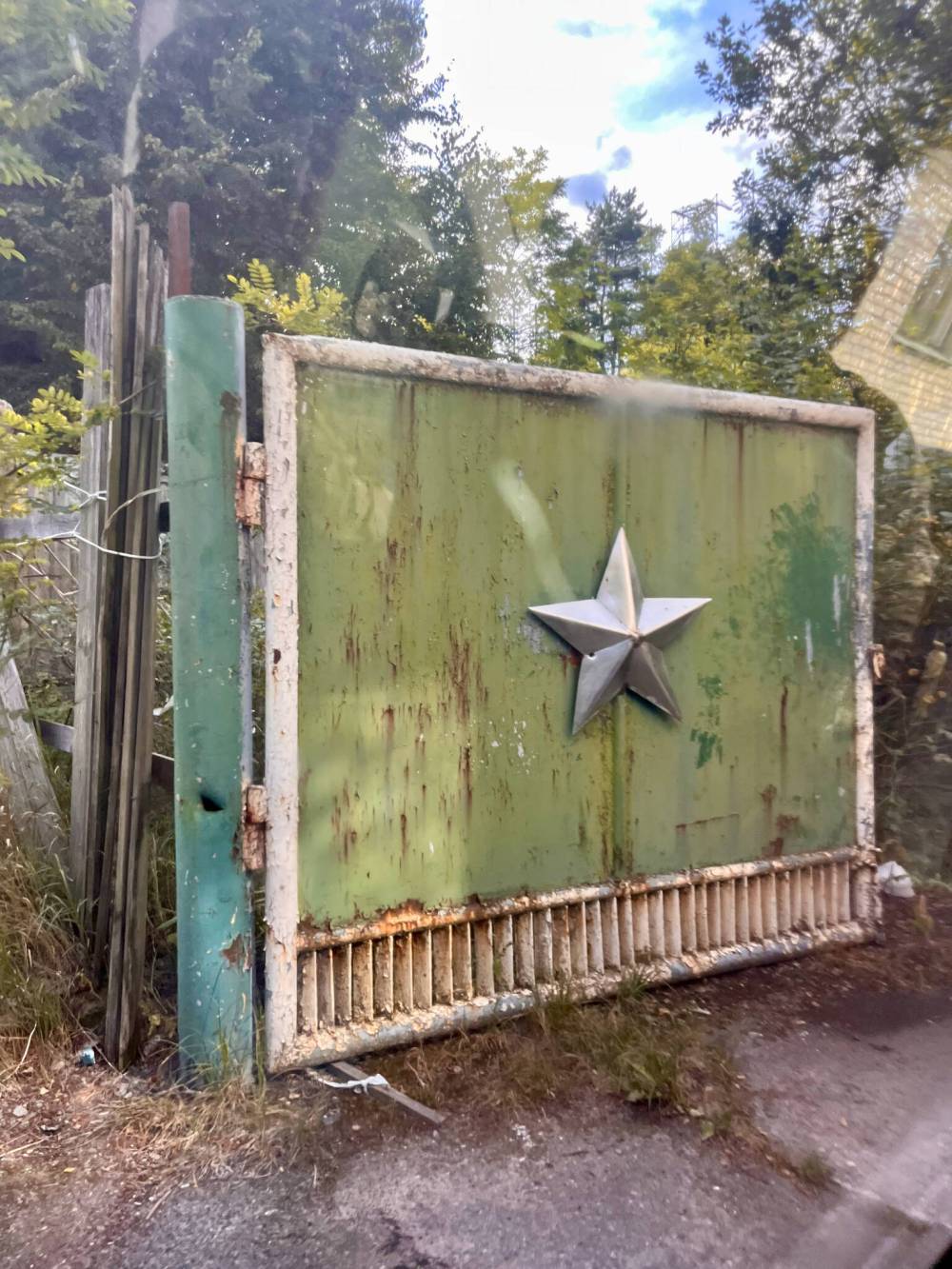
MELISSA MARTIN / FREE PRESS
The rusting gate of a Cold War-era Soviet military facility, located deep in the Chornobyl Exclusion Zone.
For nearly 30 years, Skyrta had worked in the zone, first as a police officer and, later, as an engineer. He’d been at work when the Russians invaded. Now he was trapped there, stuck under occupation, threatened daily with violence that would kill much more swiftly than the region’s simmering radiation.
Over two-and-a-half years later, the Russians are long gone from Chornobyl. But Skyrta is still there, and the memories of surviving under the zone’s occupation are still etched in his mind.
“Life is the most important thing a person has,” he says, speaking through a translator in Russian, the most common first language where he grew up in eastern Ukraine. “You want to live. And when you feel there is nothing that divides you between life and death, you start to treat life differently.”
It’s a hot day in late July. We meet Skyrta at his workplace, a radioactive waste disposal site of low industrial buildings and pre-fabricated barracks tucked in on grassy scrub land. A short drive away, the gleaming steel dome that covers Chornobyl’s ruined reactor looms over the road like a surreal sentry, its massive hull soaring 108 metres towards the sky.
Skyrta leads us to the shade of a small gazebo, and settles into talk. He is a broad-shouldered man, looking younger than his 50 years, with a gregarious smile and sharp, searching eyes. He can’t say much about his work in the zone — tending contaminated sites requires discretion — but he has much he wants to say about what he witnessed under occupation.
When war came to Chornobyl, it was sudden. That morning — Feb. 24, 2022 — Skyrta and his colleagues awoke to the rat-tat-tat of gunfire, and urgent phone calls warning the invasion had begun.
Sirens wailed. Evacuations started. Ukrainian forces, seeking to avoid combat near the stricken nuclear plant, gave up the zone without a fight. Most workers fled, in some cases escaping the onslaught by a matter of minutes; others, including Skyrta, had to stay behind to safeguard the nuclear sites.
By mid-morning, Skyrta saw the first Russian armoured vehicles rumbling south, towards Kyiv. Soon, the trickle became a non-stop flood. Russian soldiers confined workers in their barracks in the town of Chornobyl. After the first week, their phone and internet lines were cut, and then they had no news of what was happening in Ukraine.
MELISSA MARTIN / FREE PRESS
A post box in the abandoned city of Chornobyl.
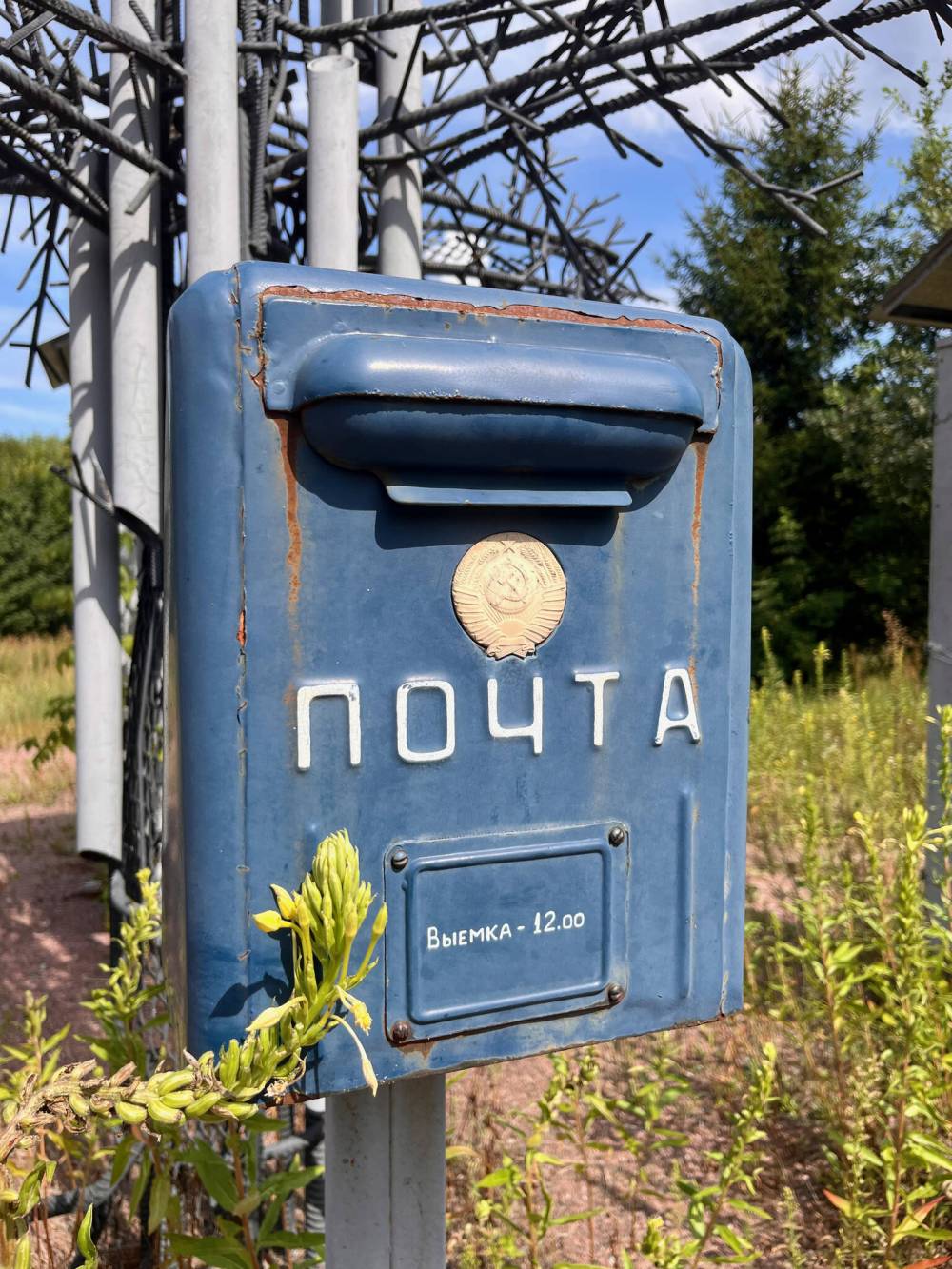
Days passed, and the flood of tanks and troops kept coming. Missiles and fighter jets shrieked overhead. Sometimes, Skyrta remembers, the night sky would glow bright as day, lit by distant explosions. Russian troops looted laboratories and barracks, stealing everything from kettles to specialized scientific equipment.
“Everything that was possible to take, they would take,” he says.
Food became scarce. So did water. Skyrta worried about his family, far to the east in the Kharkiv region: were they safe? He had no way to contact them. He worried about Ukraine: had it fallen? As he watched columns of military vehicles prowling south, he thought grimly that Kyiv must already be overrun.
“It was the hardest time,” Skyrta says. “You could hear everything, every direction. Everywhere there was fighting. There was a feeling that something big is happening, but we didn’t have any idea what was going on in reality. It didn’t look good.”
Many journalists have come to the zone, since the invasion. Many of them have asked Skyrta what it was like to live under occupation. It’s difficult for him to explain. People “think it’s like in the movies,” he says, by which he means it’s a story that has both start and end: an actor plays a role for a time and, when the story is finished, sets the character aside and slips back into their normal life again.
But for those who survived occupation, Skyrta continues, there’s no such returning to normal.
Think about it, he says. The occupiers come into your world, and force you face-down on the ground. They jam the muzzle of their rifle in your back. They demand to know who you are.
In that moment, “there is only one step between you and eternity,” he says. “This is the line between that kind of day and now. The relation to your life and relation to everything around you changes at once. You divide your life between before and after.”
For him, the “after” began one day in late March 2022, when Chornobyl workers noticed that the stream of Russian vehicles had begun to flow north, back towards Belarus. For most of a week, Skyrta and his colleagues watched them go, wondering what it all meant.
Then one morning, they woke up to find only silence.
MELISSA MARTIN / FREE PRESS
The public swimming pool in Prypiat, named after Vladimir Lenin, first leader of Soviet Russia, was one of few city amenities used after the disaster — by liquidators and area workers until 1992.
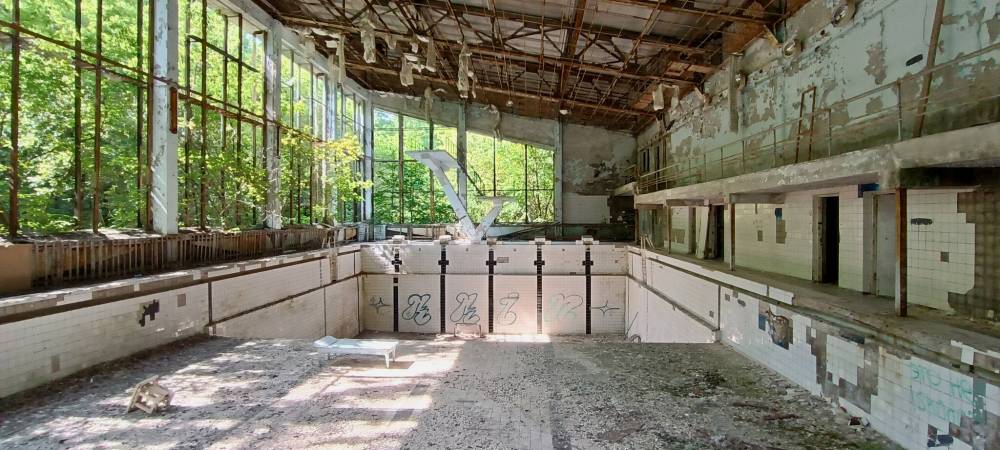
No explosions. No gunfire. No growling tanks. Cautiously, Skyrta and his colleagues ventured out of their barracks and began to explore the zone. The roads were empty. They drove to the power plant: no Russians. They visited some of the elderly villagers that stubbornly eke out life in the zone; those residents hadn’t seen any soldiers either.
The occupation of Chornobyl had ended, just as suddenly as it had begun.
It was then, as Skyrta passed a grassy clearing in the Rudyi Lis, that he saw for the first time what he hadn’t at first believed: there it was, a tangle of trenches carved into the soil — deep enough, likely, to reach the layers that held much of the buried radioactive particles.
Today, the remains of those trenches are still visible, though just barely, now flooded and taken back by marshy grasses. Why does Skyrta think they did it? He raises an eyebrow, and his lips tighten into a sardonic smirk.
“Because it was an order.”
Geo Filippov photo
The towering Duga Radar installation, a powerful Cold War-era early-warning system located in the Chornobyl Exclusion Zone.

(Reports later emerged that some Russian soldiers who had been posted in the zone had been hospitalized with radiation poisoning. “Probably, some died,” another longtime Chornobyl-area worker says, with a shrug. “We don’t know.”)
When Ukrainian soldiers took the zone back, residents rushed out to hug them. Soldiers raised their blue-and-yellow flag over the peeling white paint of the stylized sign marking the entrance to the city of Prypiat, abandoned after the nuclear disaster 38 years ago. The flag waves there still, faded and frayed from two-and-a-half years in the sun.
In the months after the zone’s liberation, work in the area slowly resumed, though it is still far from normal. Tourists aren’t allowed anymore. Soldiers and checkpoints are stationed all over the region, braced against the threat of another incursion. (In August, Ukraine issued a public warning to Belarus, which was massing troops for reported military exercises near the border.)
So the world’s most radioactively contaminated tract is safe now, in the way the workers who have tended it for 38 years are in control. It is not safe, in the way that it still hangs in the fragile balance of war. Iranian-made Shahed drones regularly pass over the zone on their way to strike Kyiv and other nearby cities.
What, we ask Skyrta, can be done to protect such a sensitive region?
“Many people come and ask the same question,” Skyrta says. “You’ll never be able to protect critical objects like this. There’s just no way. It’s all in the hands of those who come in order to kill. If they decide to not do that, it will never happen.”
He shakes his head.
“The nature of humans is not to build, but to destroy,” he says, as we prepare to leave him to his work. “It’s really sad, because we’re destroying the beauty of the world. We cannot enjoy it enough… and it’s going to get worse.”
One last thing. When Ukrainian soldiers returned to the zone, they built defensive fortifications near Chornobyl too. Only theirs are above-ground, rounded sandbag mounds snaking through the Rudyi Lis, an artifact of the new nightmare layered over the buried poison of the old.
Something strange happens when you cross into the Chornobyl Exclusion Zone. Everyone who goes there feels it, though it’s hard to pinpoint why. To the eye, little is different. The line between inside and out, between safe and poisoned, is invisible; the forest spreads lush on both sides.
In fact, were it not for the security checkpoint at the border, manned by stern police, there’d be no way to know the moment you step over the line.
Yet when you do, knowing that you do, you feel the world shifting: an eerie sense of transition, as if passing through a veil that falls only in the mind. You’re somewhere else now. The rest of Ukraine, though contiguous, suddenly seems distant. Tour guides have seen visitors become nauseous within minutes of entering the zone, though the radiation is no higher than it was at the border, and far too low to pose immediate danger.
In this spirit, Chornobyl workers call the world outside Velyka Zemlya — the Great Land.
“They’ll say, ‘I’m going to the Great Land tomorrow,’ because when you are there, you’re in the island of Chornobyl,” says Oleksandr R., a scientist and guide who’s worked in the region since 2009. This mental demarcation “shapes everything,” he continues. “It shapes even geography, perceptions of territory, perceptions of space and time.”
SUPPLIED
Scientist Oleksandr R. and wife Michaela, a translator, suit up at the Chornobyl nuclear power plant.
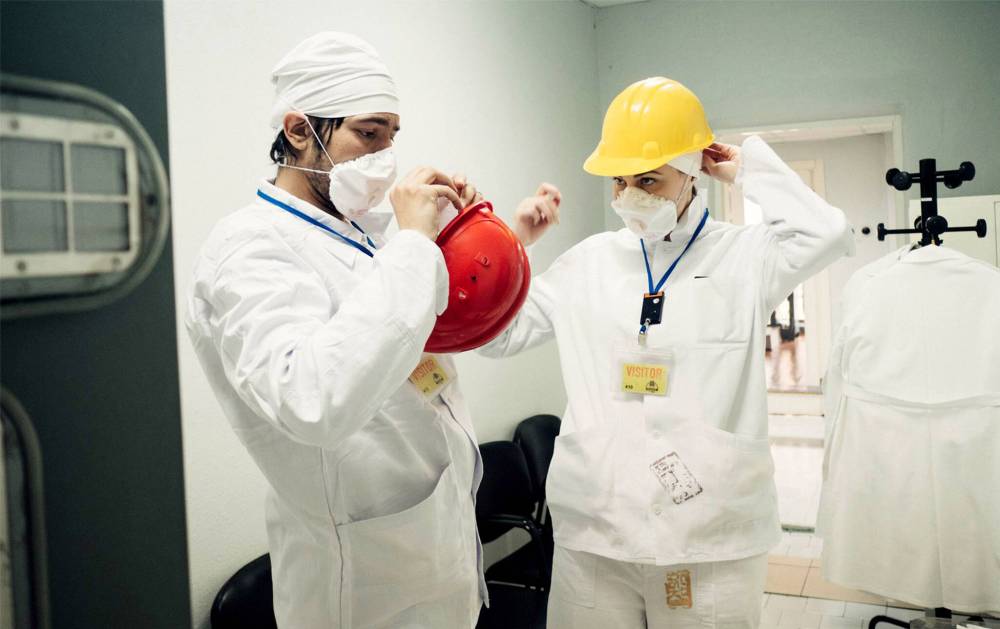
Oleksandr — who prefers his last name not be used, for safety — has spent much of his adult life considering this phenomenon. As a child growing up in Ukraine in the late 1980s, he knew Chornobyl mostly as a ghost that haunted the edges of adult conversations.
“You feel it, you hear it, but no one wanted to talk about it, not because it was prohibited, but because it was too traumatizing, still fresh,” he says. “But it’s a long-established fact that when you prohibit something from a child, it will become like a splinter in the mind.”
For Oleksandr, that youthful curiosity became a lifelong fascination. He made countless visits to Chornobyl, before taking a job there as a researcher; he even met his wife, Michaela, in the zone. Originally from Slovakia, she too had grown transfixed by Chornobyl after a 2011 tourist visit, and kept coming back, eventually finding work there as a translator.
So Chornobyl brought them together, and Chornobyl became the core around which they built their lives. (“Sometimes I think this place has a greater logic,” Oleksandr says. “It took so much from people, sometimes it should pay back.”) They moved to a village right on the zone’s edge, bisected by its barbed-wire border, and guided tourists through its eerie abandoned ruins.
Geo Filippov photo
A gas mask that was left behind in a Prypiat elementary school decades ago.

In 2020, hoping to share their encyclopedic knowledge of the zone with a wider audience, the couple launched a YouTube channel, Chornobyl Family. Their videos delve deep into the area’s technological and human history: together, they restore Soviet equipment used in the disaster; explore Chornobyl’s ancient history; and analyze the images on Cold War-era film slides found in an abandoned Prypiat school.
That mix of passion and precision has found its niche. Today, the channel boasts more than 40,000 subscribers, and their most popular video — an exhaustively researched documentary about Chornobyl’s original SKALA computer, which they convinced authorities to save from a waste burial trench — has nearly half a million views.
So what is it about Chornobyl that still captivates so many people, all these years later?
That was the main question on my mind when I met the couple at a café in downtown Kyiv this summer, not long after my visit to the zone. It’s an interesting phenomenon, Oleksandr agrees. After all, he points out, before the full-scale invasion, many people in the world had only a dim awareness, if at all, of Ukraine as a country; but almost everyone knows Chornobyl.
Of all the catastrophes of the 20th century, few seeped as deeply into our collective memory — and popular imagination — as Chornobyl. The disaster, and the zone which bore the brunt of its effects, have been explored in dozens of books and documentaries. They have inspired horror films, novels, multiple video games and an acclaimed HBO series.
Partly, the reason behind this enduring fascination is that “nothing ever ended there,” Oleksandr muses. Its radioactive contamination will outlast civilizations; for as long as humans exist, the stricken reactor and its poisoned environs will need to be tended.
And while the zone is safe now for limited visits — most of its 3,000 workers keep a two-week-in, two-week-out schedule — it may never be safe for permanent habitation. So that’s also part of its mystery: the vastness of “never” is something the human mind struggles to comprehend.
“It’s one core thing which is quite important to understand,” Oleksandr says. “When we deal with Chornobyl, we deal with eternity. It operates at such scale that we are just guests there. We need to keep this place safe, we need to protect it, we need to maintain it. But it actually works on a cosmological scale — that is a place which makes people think about existence.”
Yet Chornobyl has another story to tell, one that’s unexpected, and even hopeful.
Geo Filippov photo
The zone is safe for limited visits but it may never again be safe enough for permanent habitation.

In most of its popular depictions, the zone is presented as a dystopian wasteland, ominous, a ghost world imbued with an unseen malevolence. Even just the name Chornobyl is often used as a warning about the risks of our hubris — a dire warning to humans not to play with fire we cannot control.
What’s less often reflected in these depictions, however, is that it is still very much alive.
Today, Chornobyl is a place of remarkable beauty. Wildflowers caress the disintegrating remains of Cold War-era military installations; its forests teem with animals, including a rare wild herd of endangered Przewalski’s horses. (In May, one of those horses was killed after it stepped on a Russian mine.)
And the zone is also one of the most scientifically valuable places on Earth, offering researchers a unique chance to study the long-term ecological impacts of radiation — what Michaela calls “the biggest open-air laboratory” in the world.
“The zone is like a mirror for your soul,” Michaela says, reflecting on her experiences as a tour guide. “Many times people came there just to search for some kind of super-depressive place, because they themselves were super depressed. I was trying to show them all possible points-of-view on the zone, because the zone is not just a disaster.
“Future technologies are tested there,” she continues. “You can find that depressive, but on another hand you can find that incredible future stuff that you will never see anywhere else. And big potential. Many of the people who went there with me said that when they returned, their life absolutely changed.”
Now, perhaps, Chornobyl’s lessons — past and present — hold a renewed meaning.
Like all Soviet nuclear power stations, the Chornobyl plant was not under the control of the nominally autonomous Ukrainian Soviet Socialist Republic, but overseen by authorities in Moscow. (The Ukrainian government was not even informed about the disaster until hours after it happened.) Yet its enduring burden falls squarely on an independent Ukraine: in average years, between five and seven per cent of Ukrainian government spending goes to managing the zone.
MELISSA MARTIN / FREE PRESS
Once a broad, open public plaza with neatly manicured trees, today the centre of Prypiat has been taken over by forest.
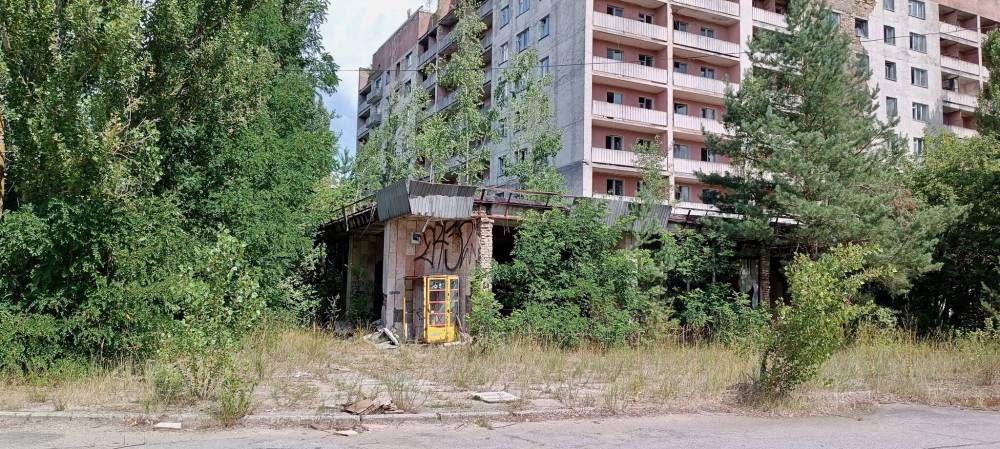
Then there’s the human cost. When the reactor exploded in April 1986, the catastrophe forced 116,000 people from their homes. A handful of residents refused to leave; Ukrainian authorities allow them to stay, though new residents are forbidden. Today, about 150 elderly samosely, or self-settlers, remain. But most who left in 1986 never saw home again.
What they left behind in Chornobyl was everything. The places they knew, the lives they were building, and much of their belongings. And before 2022, when Oleksandr and Michaela took tourists through the zone, that’s what they tried most to impart. It’s not ghosts that haunt the empty apartments of Chornobyl. It’s real memories, of real people.
“We of course had many people who came because of the mass-culture stuff,” Oleksandr says. “But some people, if they went with us, could understand that there is so much more. Without our stories the zone is just radioactive ruins, which might be very beautiful. But you must give a chance for people to understand that could be your home, that your story can abruptly end with all that you know, all that you love.”
MELISSA MARTIN / FREE PRESS
A woman’s shoe, once clad in red velveteen, lies on the floor of Prypiat’s Palace of Culture.
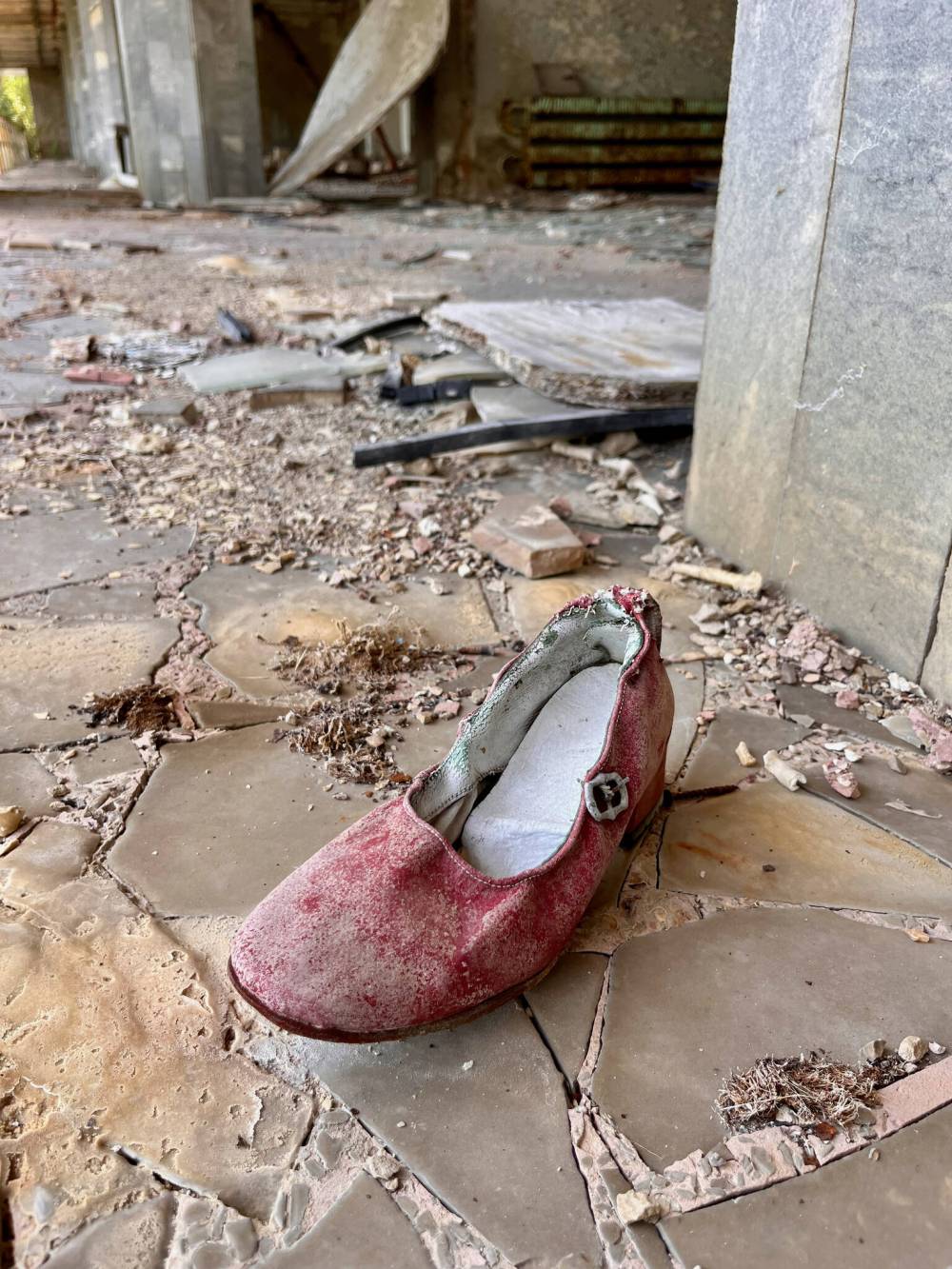
It’s not lost on Oleksandr just how heavily those words once again hang over Ukraine.
Millions of lives upended, thrown into harm’s way, or forced forever from home, and a burden that will weigh on the nation for generations: that’s the legacy of the Russian presence in Ukraine at Chornobyl, and it’s the legacy that Russian presence in Ukraine is wreaking now.
Then, it was Prypiat. Now, it is Mariupol, Pokrovsk, Bakhmut and Avdiivka; it is countless tiny villages blasted to ruin across the 3,000-km front line. The main difference is that, in Chornobyl, the weapon of displacement was invisible. One form of destruction is loud, the other silent, but both equally devastating to the peaceful course of human life.
History doesn’t repeat, but it rhymes.
“Chornobyl is a phenomenon, it’s a lesson,” Oleksandr says. “If this invasion happened, this means lessons were not learned. Among those people who came here, among the invaders, there were people who obviously had their parents as liquidators, those who suffered, those who were affected. And still they brought this great metaphysical Chornobyl.”
He pauses.
“After all, Chornobyl is not just about radiation and barbed wire,” he continues. “If you really go into the documents, you’ll see it’s about approaches to the system. Systems of ignorance, and systems of delusions. Hiding the truth, and telling the lies… So, I’m pretty sure the side which now made this invasion, they’re the same kind of double standards.”
There was no panic in Prypiat that morning, Volodomyr Verbytskyi remembers. It isn’t because they didn’t understand the danger. True, the explosion had rocked the Chornobyl plant’s fourth reactor late at night, when most of the city’s 50,000 residents were sleeping; and there was no immediate announcement from tight-lipped Soviet officials.
But the majority of adults in Prypiat worked at the nuclear plant, so as they awoke, word of the disaster spread quickly. By the time an official came around to deliver the news, Verbytskyi, like most residents, already knew something terrible was unfolding.
“What the government was doing was unimportant,” he says. “Of course they tried to keep it secret. But locals knew, especially those who worked at the station, so everyone knew right away.”
MELISSA MARTIN / FREE PRESS
Volodymyr Verbytskyi, who grew up in Prypiat and still works in the Chornobyl Exclusion Zone, holds up a dosimeter in city’s Palace of Culture.

The evacuation began the next day. Though the government still tried to conceal the scale of the catastrophe — Soviet officials infamously did not announce it until after Swedish nuclear authorities pressed them two days later — buses and vehicles rushed from all over Ukraine to ferry the area’s residents to safety.
Everyone was calm, Verbytskyi recalls. The evacuation was orderly. It wasn’t like the chaotic images that streamed out of Ukraine 36 years later, as civilians fled the Russian invasion. He was one of those, too: on Feb. 24, 2022, he jumped into a car and, for the second time in his life, fled the Chornobyl region, escaping advancing Russian troops by mere minutes.
“It was a little different because it’s war,” he says. “When we were about to leave (Chornobyl in 1986), our lives were already settled down, so we had our hopes. And it’s because radiation has no smell, no colour, no face, so it’s hard to convince yourself that you need to leave when everything seems fine. Yesterday was fine, and today is fine, but now you need to leave.”
It’s afternoon in the zone. We’re driving down the narrow, silent highway that links the nuclear plant to Prypiat, about five kilometres away. In the passenger seat, Verbytskyi holds up a small yellow dosimeter. As we round a curve in the road, it issues a frantic flurry of beeps, indicating a sudden spike in radiation levels.
That’s the tricky part about the region, guide Mykhailo Teslenko explains from the driver’s seat. There’s no rhyme or reason to the hot spots; after the disaster, wind and rain simply dispersed particles more densely some places than others. So one step might put your feet on relatively clean ground; the next, on dangerously poisoned soil.
MELISSA MARTIN / FREE PRESS
At the time of the 1986 Chornobyl disaster, an amusement park was set to open in Prypiat. Sadly, its Ferris wheel was never used.
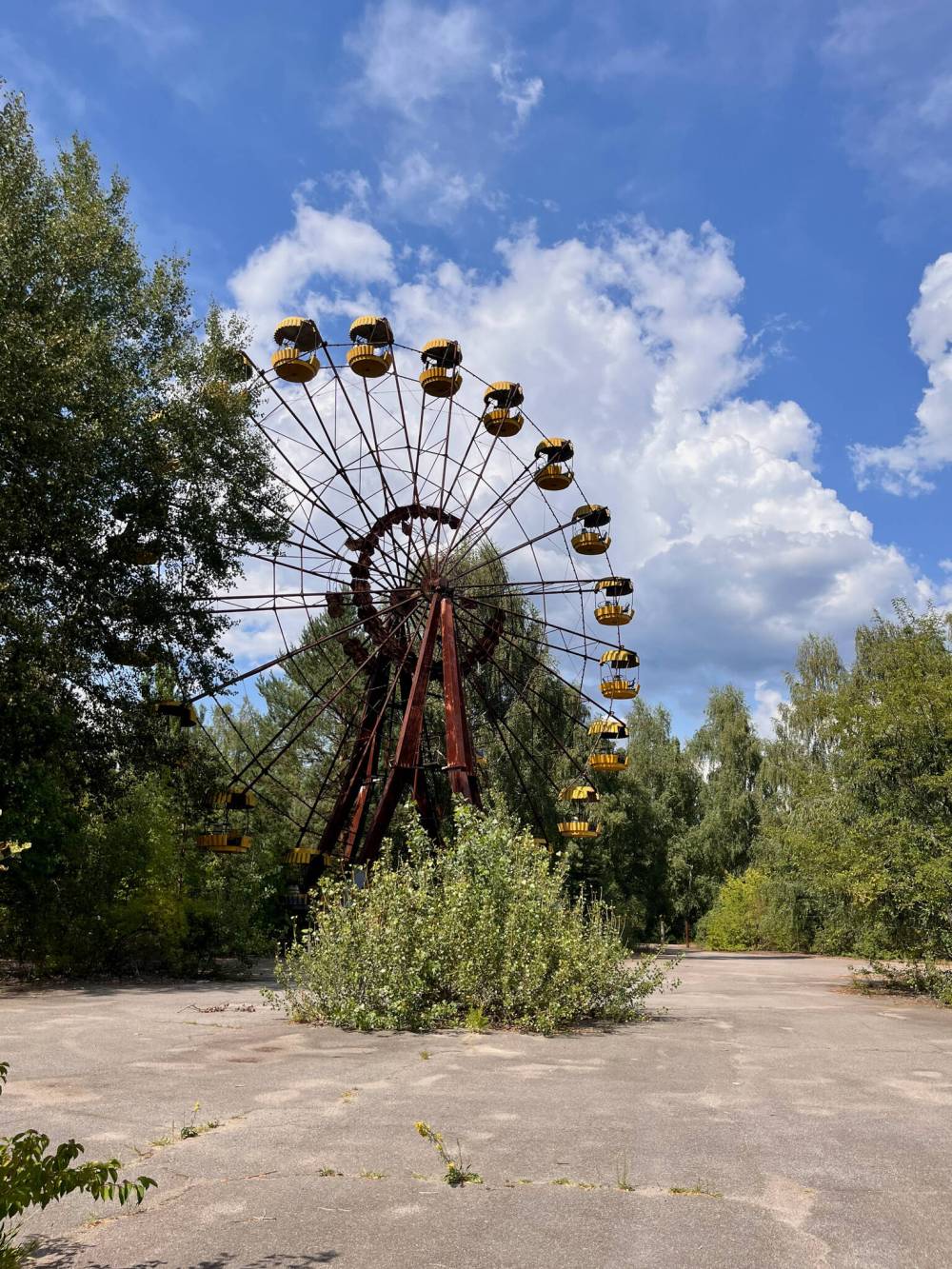
“The main function of the entire Exclusion Zone is just to prevent the spreading of radioactive isotopes outside,” Teslenko says, as the dosimeter’s beeping calms down to normal. “As long as they manage to keep them here… It’s just to protect the rest of the world.”
To think that this was once one of the most desirable places for young families to be.
At its birth in 1970, Prypiat rose like a manicured jewel in the Polissia forest, proclaimed as a Soviet “model city,” a utopian idea of what a workers’ town could be. Its apartments were, by Soviet standards, large and modern; residents were treated to a bevy of amenities, including a cinema, a sparkling public pool and dozens of cafés. In April 1986, a new amusement park with bumper cars and a Ferris wheel was about to open.
Salaries were high at the power plant, up to 350 rubles a month for nuclear specialists, putting them in the top one per cent of Soviet earners. The schools were renowned for their quality; even now, pride slips into Verbytskyi’s voice as he recalls statistics that Prypiat graduates had such high test scores, they were regularly admitted to the top universities in Ukraine.
So for some residents, many of them leading scientists and technicians from across the Soviet Union, life in Prypiat seemed almost too good to be true. Verbytskyi’s maternal grandparents were ethnic Kalmyks from Siberia: “It’s quite tough living there, you understand.” By contrast Prypiat, with its comparatively forgiving climate, was “very comfortable, very convenient.”
MELISSA MARTIN / FREE PRESS
A pair of chairs still sit in a room of an apartment in Prypiat, abandoned after the 1986 nuclear reactor disaster.
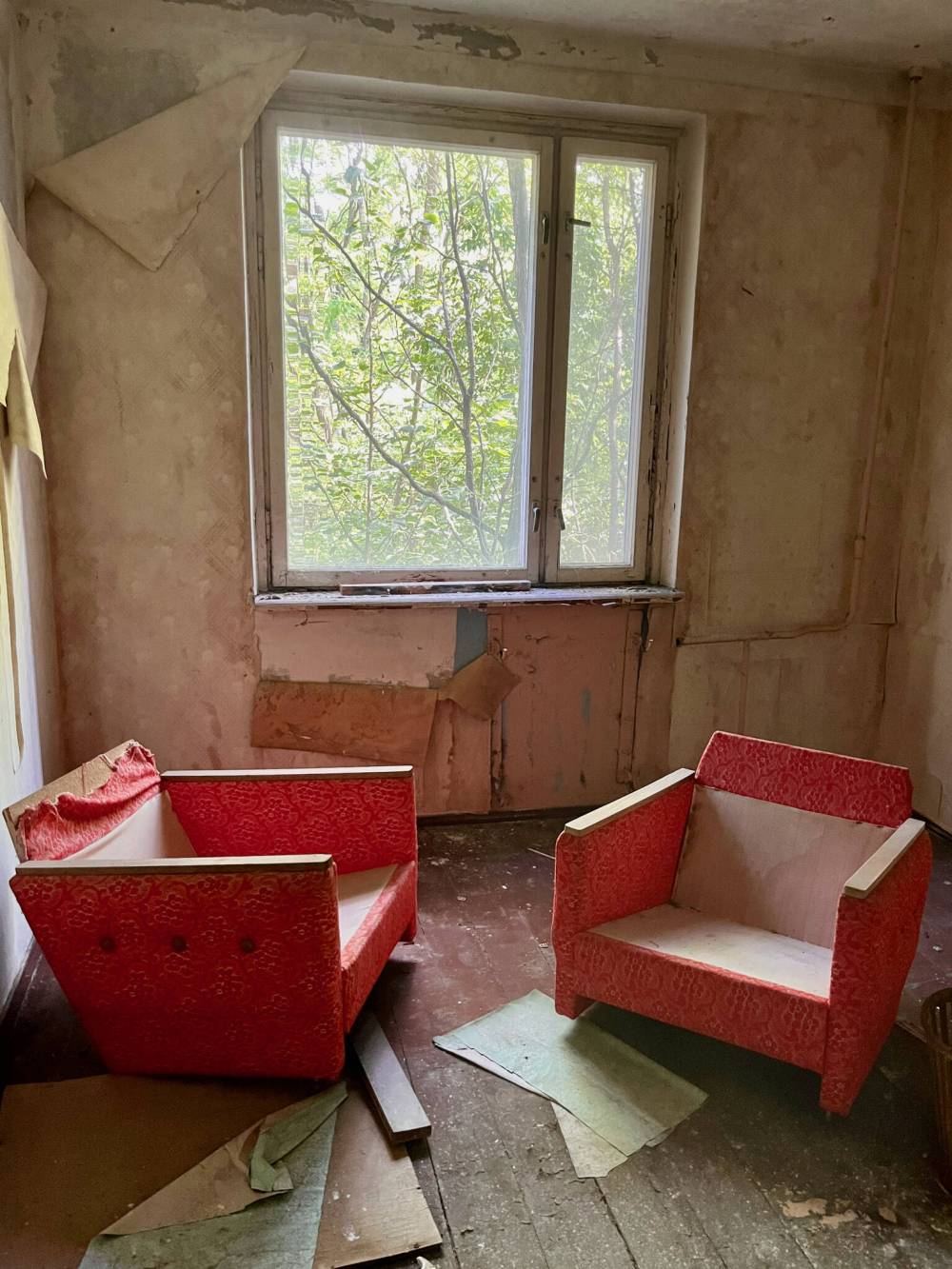
For Verbytskyi, Prypiat was always home. He’d moved there as a child in the 1970s, when his mother landed a job at the nuclear plant. As a young man, he served his mandatory stint in the Soviet Army, fought in Afghanistan, came home, and started working at the nuclear plant as a welding inspector.
Life was good then, for a time. He married his wife — it helped settle him, he thought, after the trauma of war — and they started a family. On the day of the nuclear disaster, his son was just over a year old.
“Actually,” Verbytskyi says, pointing outside the car window, “that was my apartment.”
We follow his gaze. For a moment, we see nothing. Only the forest, the same thick green wall of slender pines and tangled bushes that hugs the road into Prypiat. Then suddenly, we spot it: the looming concrete face of a six-storey apartment block, lurking in the shadows, peering like a ghost through gaps in the trees. We had arrived in Prypiat, without even knowing.
Teslenko points the car towards the city centre, parking in what was once a broad public plaza decorated by neat rows of trees. We step out gingerly, aware of the warning to try not to touch anything with our hands. Verbytskyi leads us through the plaza, traipsing over broken concrete and past copses of overgrown saplings, until we are standing underneath the modernist facade of what was once Prypiat’s Palace of Culture.
Once, this building was the centre of public life in the city. Its walls were decorated with bright murals, painted by one of the Soviet Union’s best painters. The venue boasted two theatres, a spacious reception hall and a sunlit-filled gymnasium.
Geo Filippov photo
In the gymnasium in Prypiat’s Palace of Culture, climbing ropes still dangle from the ceiling. Once a sun-filled space with parquet wooden floors and expertly painted murals, such facilities were central hubs of community life in Soviet cities.
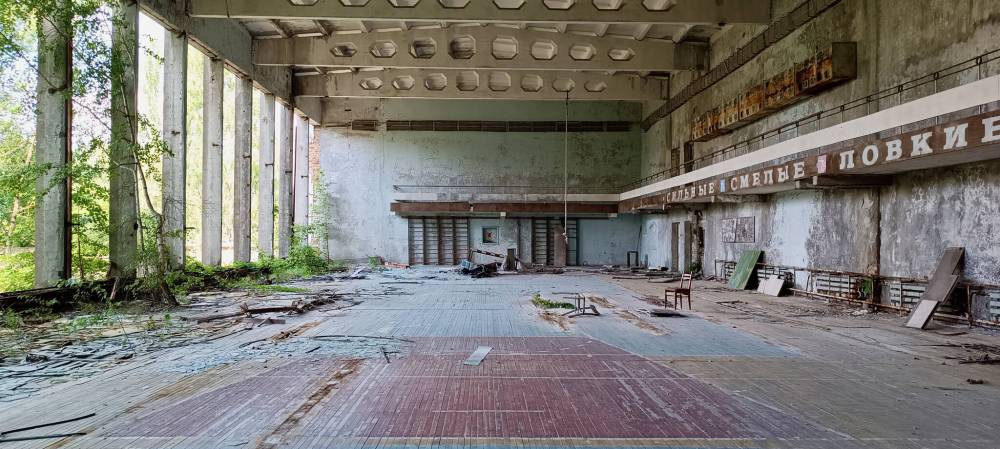
Every year on April 1 — a popular holiday in the Soviet Union — residents used to gather at the Palace for what they called Vecher Smekha, Evening of Laughter, a night of folksy comedy and entertainment. It was a happy time, an evening to enjoy life in the model city.
“Everyone felt that we were a community in this town,” Verbytskyi says.
Today, only the skeleton of that life remains. Verbytskyi leads us into the Palace of Culture, past a fading mural and up a set of crumbling stairs to the second-floor atrium. Here, the soaring windows tumbled inwards long ago, and shards of glass crunch under our feet. We sweep it away with our toes to reveal the remains of an intricate parquet floor. A woman’s red velveteen shoe lies wedged against the wall.
This is the dystopian imagery that so fascinates Chornobyl watchers and, until recently, drew tens of thousands of tourists to the zone. Prypiat has been called a modern Pompeii, one of the rare examples of a city that was partially preserved at the moment of its destruction.
Geo Filippov photo
The second-floor cinema in Prypiat’s Palace of Culture.
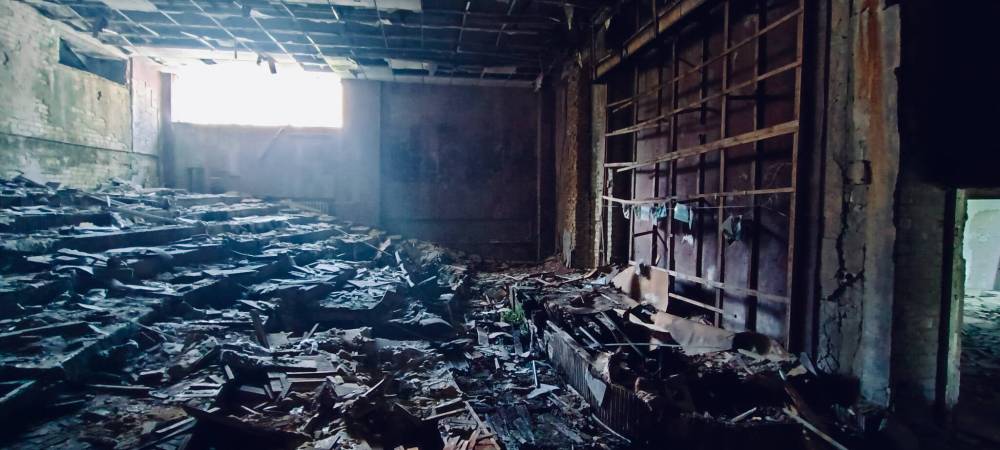
For a few hours, Teslenko and Verbytskyi lead us through some of the city’s buildings, pushing through thick tangles of bush. Inside an apartment, children’s toys, corked bottles of wine and books on Soviet thinkers are still scattered where fleeing residents left them.
At the entrance of one of Prypiat’s mouldering schools, an ominous sign warns, in English and Ukrainian, to stay out: “This building is REALLY DANGEROUS. If your guide leads you inside it, he risks your life. Don’t risk your life! Do not enter!”
Teslenko breezes inside. “Don’t worry,” he says. “All the buildings in Prypiat say that.”
When Teslenko started guiding, in 2010, Chornobyl saw about 4,500 visitors, annually. By 2019 — the last normal year, before COVID-19 and war — the Exclusion Zone saw 125,000 visitors, taking tours as long as five days. Then, they could go inside the power station, even inside the control room that oversaw the nuclear disaster.
Geo Filippov photo
A Ukrainian-language book about a historical worker’s strike lies on the floor of the gymnasium in Prypiat’s Palace of Culture.

Now, with tourists forbidden, it’s been many months since Teslenko’s last visit. As he walks around the city, he pauses to snap photos of where the forest has invaded its sidewalks and buildings. The pace of nature’s reclamation is accelerating, he thinks; he points to the top of one eight-storey apartment near the central plaza, where skinny saplings sprout from the roof.
Someday, their roots will force open cracks in the structure that bring it tumbling down.
“When people were coming, when visitors were coming, it wasn’t like this,” Teslenko says, with a shake of his head. “It’s amazing how fast nature reclaims everything. Honestly, I think that in the next 10 years, it will disappear.”
As we get back in the car and drive away from Prypiat, I wonder what that realization must be like for Verbytskyi. He fled Prypiat once, but never really left Chornobyl. He remained there as a worker — he still works at the plant today — but also, it stayed with him, sunk into his bones and those of his family. This year, his son died of cancer, at just 38 years old.
For him, there must be two Prypiats, two Chornobyls. The one he remembers, filled with family and work and hopes for their future; and the one in front of him now, an open-air museum filled with the artifacts of that life, with a flourishing wilderness devouring its bones. What’s it like for him to hold the simultaneous image of both of those states?
For a moment, Verbytskyi says nothing. His expression is opaque.
MELISSA MARTIN / FREE PRESS
A bottle of wine sits in the closet of an apartment in Prypiat.
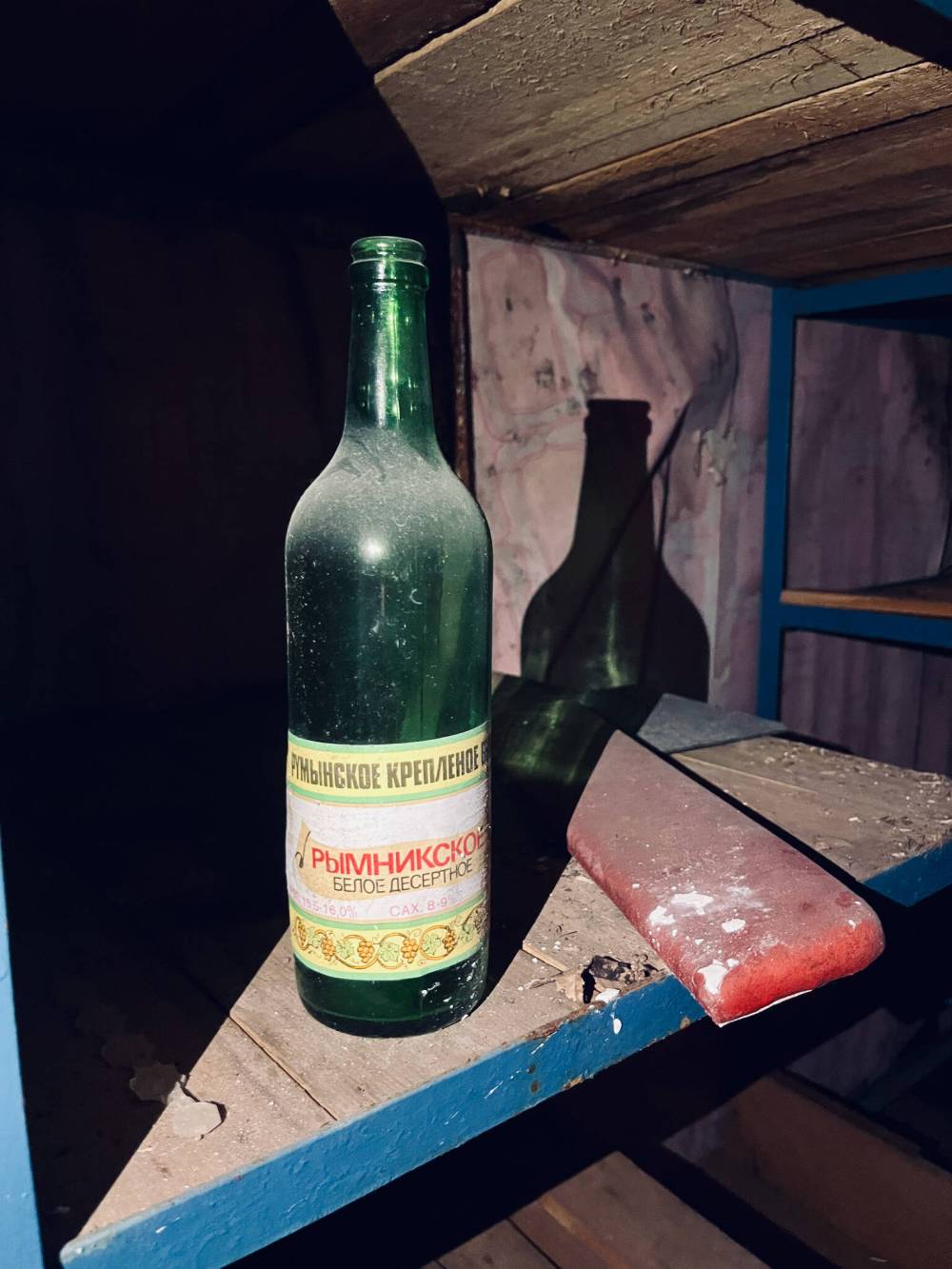
No, he says slowly, he doesn’t like to go into the building where he lived. He’d rather not think about it too much. But he never stopped working at Chornobyl, and he’s been guiding visitors there for a long time. So he tries to approach it as a professional. It’s just work.
You understand, I note, why I’m asking. It’s because there are millions more Ukrainians now, for whom this same story is unfolding. Who will spend their lives squaring the memories of a home that was, and is no longer.
Verbytskyi nods, then adds a thought.
“Many of my friends don’t go to Prypiat because they don’t want to have that psychological shock,” he says. “One of my friends, she says ‘I don’t want to go back there, because when I was there everything was fine, and when I’m here now everything is not fine.’”
Night is gathering over Ukraine. We reach the security checkpoint at the zone’s border a short time before it closes. We present our passports to a guard and are ushered into a nondescript building where we pass through a radiation detector, pressing our hands and the soles of our shoes to its sensors.
The detector’s lights blink green. We’re clean, we can leave.
Out of the Chornobyl Exclusion Zone, back into the Great Land. Out of the disaster that was, into the one that is now. That night, air-raid sirens sound in Kyiv. That week, humanitarian teams step up frantic efforts to evacuate civilians from besieged Pokrovsk, far to the south and east. Some won’t leave, mostly elderly folks who vow to stay till the end, aware that, when they flee, they may likely never see home again.
Geo Filippov photo
Prypiat’s Palace of Culture sits in a state of decay.

Melissa Martin is the Free Press writer-at-large. She is currently on leave in Ukraine.

Melissa Martin
Reporter-at-large (currently on leave)
Melissa Martin reports and opines for the Winnipeg Free Press.
Every piece of reporting Melissa produces is reviewed by an editing team before it is posted online or published in print — part of the Free Press‘s tradition, since 1872, of producing reliable independent journalism. Read more about Free Press’s history and mandate, and learn how our newsroom operates.
Our newsroom depends on a growing audience of readers to power our journalism. If you are not a paid reader, please consider becoming a subscriber.
Our newsroom depends on its audience of readers to power our journalism. Thank you for your support.

